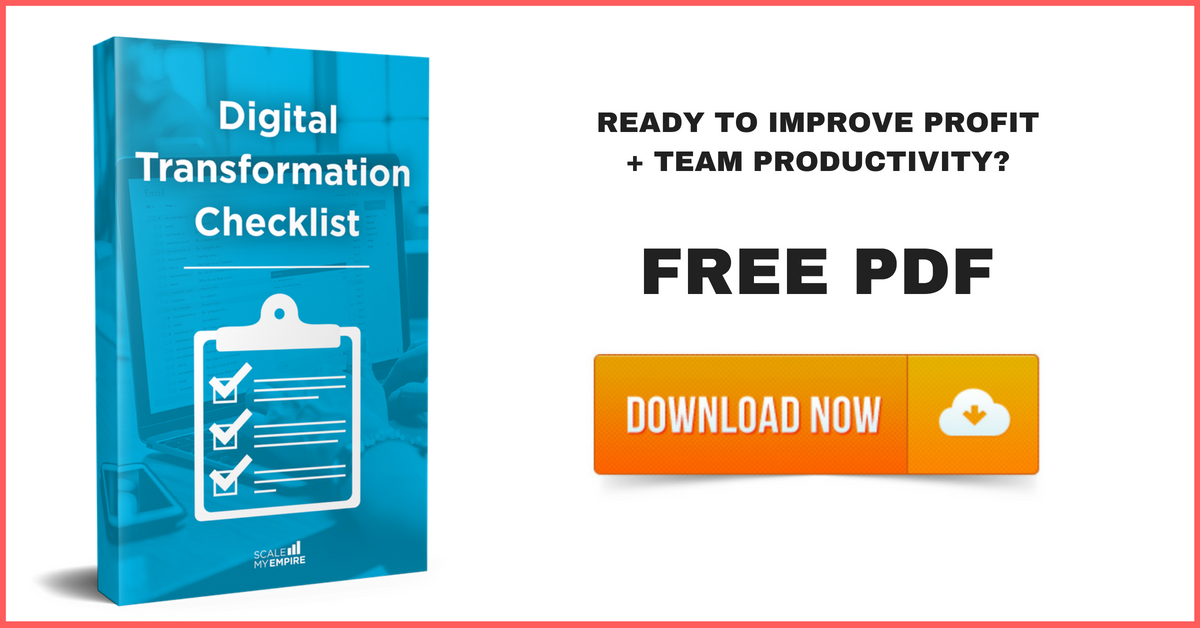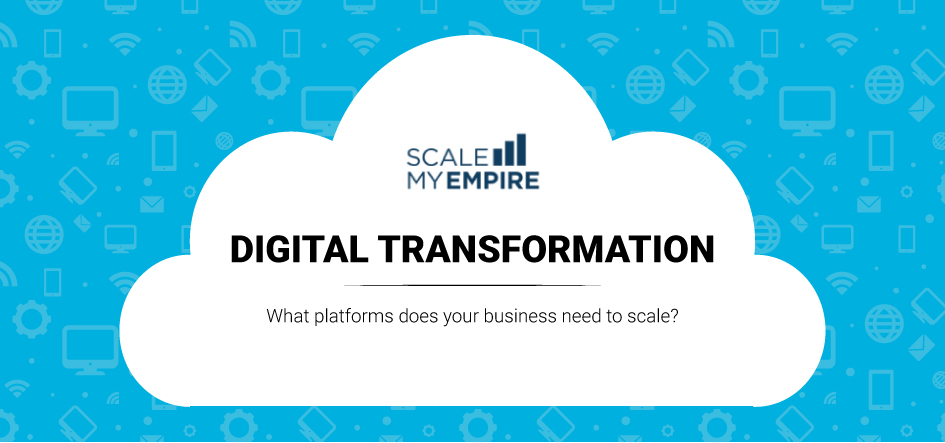
If you are scaling your services business, there are several absolute must have technologies that will make the transition from small to medium easier, faster and more profitable.
Some of the biggest challenges you have on the journey to properly scaling your business – outside of hiring, market cycles and external forces – are keeping your team productive and having visibility over your company’s position so that you can make smart decisions.
Both of these challenges can be addressed and helped with technology platforms.
But, which ones? What do you actually need and why?
Let’s take a look at a formidable tech stack that’ll easily aid your business’s scaling aspirations.
If you’re in a hurry, we’ve put together a list of our recommended tools in one easy reference PDF. Grab it here:
Want the essential tech stack to digitally transform your business? Grab it here. Click To Tweet11 Tools You’ll Need To Scale From Small Business to Medium Business
In order to scale your business effectively, it’s necessary to have the right tools.
This is what we call a “tech sandwich” or “technology stack.” Having a stack of the best tools is the most efficient way to approach scaling!
This list is vendor-agnostic as we want to give you an explanation of what types of tools you’ll need to get more productive and reduce your costs, thus improving your margin!
- Files and productivity (your core infrastructure)
- CRM
- Project management
- Resource management
- Accounting software
- Team collaboration
- Intranet
- Online scheduling
- Virtual meetings
- Contract signing and management
Now, let’s look at why each of these components is important for everyone’s tech stack.
If you’d like a list of the specific tools we recommend to all of our clients, you can download that for free here.
What's a #techstack and how could it help you scale your company? Find out how by reading this! Click To TweetThe Ideal Tech Stack For Digitally Transforming Your Business

Files and Productivity (the ‘Core’)
Let’s start with the must-haves.
I mean the really must-haves.
In the 21st century, you can’t do business without email, a digital calendar and the ability to create, store and share files with your team and clients.
That’s the obvious stuff – documents, spreadsheets, presentations and the like.
What you need to consider as a services business in the digital age is the ability to do this from anywhere in the world, anytime and without the huge IT costs that used to be associated with this kind of freedom.
That’s where cloud productivity systems come into play.
These software tools sync your local computer up to files, email and calendars in the ‘cloud’ – you can access them from anywhere.
More importantly, they are automatically backed up, highly secure while also being easy to share with your team and clients.
Quite often the rest of your tech stack will integrate directly with these tools, so it’s important to choose the right one from the start.
This is definitely the foundation of your digital transformation.
CRM Software
Customer relations is a fundamental aspect of a successful business.
How are you going to scale if your customers don’t rely on or are loyal to your company?
That being said, as you focus on your company’s growth, you may find less time to interact with your customers as you once did.
CRM (customer relationship management) comes into play here: It’s a way to alleviate some of the work that you and your employees have to do in terms of customer relations.
In fact, CRM programs are used for much more than just alleviating the load of daily and sometimes tedious tasks. A lot of the things you once did to support customer relations can now be automated with CRM.
For example, CRM can help you to track customer responses, trends, and other forms of important data.
Most rely on some form of AI (artificial intelligence) to perform tasks such as responding to customer queries, feeling for leads on popular platforms like Facebook, and even providing valuable information for your company’s current customers.
All said, the most important feature of your CRM is the ability to actually forecast and track your sales revenue.
With a CRM, you can enter your prospects, estimate their value and when you expect the sale to go through. This means you can report on your sale forecast vs your performance – a critical metric you need to know when scaling your business.
Long story short: CRM software makes you and your team’s lives easier by reducing sales workload, but also gives you the insights you need to make smarter business growth decisions.
Project Management
Project Management means a lot of things to a lot of people, but you can be sure that it is the core of your services business whether you realise it or not.
Your project management system should at the very least be where your projects are broken into deliverables and tasks with budgets and resources assigned.
Time tracking is an essential feature to make sure you are not exceeding budget. As labour is likely your most important billable resource – and highest cost – this is really one feature you can’t live without.
The data you collect and report on here will be the defining measurements of your business.
A great project management tool will give you insights into profit margin, team billable utilisation and revenue growth at a minimum. Keeping your finger on the pulse of these and other measurements will ensure your services business stays ahead of the season cycles, lumpy cash flow problems and thus profitable year round.
With the rise of ‘the cloud’, project management software often includes a collaboration component as well – the ability for your team, suppliers and even clients to discuss ideas, share files and assign tasks to each other online.
If your current project management system is missing these features, particularly the reporting, then it might be time to upgrade.
Resource Management
As a services business, people are your greatest (and most expensive) asset.
When your business grows, obviously the team has to grow with it. But, with that growth comes, frankly, your most difficult challenge to scaling your business – optimising your team utilisation.
Imagine hiring 5 more team members in response to a huge uplift in business, only to find that your margins plummet.
This is very likely due to the fact that your team’s ‘billable time’ is not optimised across your portfolio – they aren’t spending enough time on billable work which is means your ratio of labour cost to revenue is increasing.
Resource management is also a bit of a dark art.
Often done on whiteboards or spreadsheets at best, it tends to have very little science and a lot of guesswork.
It doesn’t have to be this way however. A resource management system can improve your ‘utilisation’ (the % of your team’s time spent on billable work) by up to 25%.
That’s a huge and direct improvement to your bottom line and why you need to down tools and invest in this area fast.
Cloud Accounting Software
As the leader of your company, odds are that you enlist the work of an outside accountant to do your numbers for you.
Or, you may use an accounting program that’s simply installed on your computer at home, where it’s accessible to only you.
Therein lies the problem with traditional accounting software: as your company begins its growth, more people will need access to your company’s numbers.
Enter cloud accounting programs; they’re programs that utilize the “Cloud” to make important financial data accessible to anyone needing to view it, from practically anywhere.
Inevitably, more positions will unveil themselves as your company grows, some more defined than others. More and more people will need access to pertinent financial data.
Imagine having to haul your computer to someone, whenever they need to check the books!
Imagine how unsecure your company’s financial data would be if you kept it all on a flash drive since you’re the only one with the company’s financial information.
Nope – definitely not efficient or practical!
Your cloud accounting system should also be able to give you your 2 most critical reports – Profit and Loss statement and your average accounts receivable days (AR Days) on your contracts.
Accounting software is the past and cloud accounting software is the present and future, especially for businesses who are beginning to scale or are on the cusp of it.
Team Communication Software
When it comes to teamwork within a service business environment, collaboration is king.
With the fast growing trend of services businesses using remote workers to reduce cost and create happier team members, the ability for your team to collaborate across borders – physical and digital – has become imperative.
Team collaboration software is just as it sounds; it provides a means for communication and collaboration between team members about all work-related activities.
This can vary from highly structured environments you’d find in a project management software to barely structured, free flowing communicating found in tools like Slack and HipChat.
There are merits and pitfalls to both and it largely depends on the culture of your business and the nature of the work that you do.
Either way, it’s a critical part of your digital transformation.
Intranet
Having a company-specific intranet is an efficient component to small business growth and so making it effective for scaling.
As it pertains to a company, an intranet is almost like a company encyclopedia; it’s a miniature network that contains a host of information relevant to your company’s proceedings.
It may have information like HR guidelines or rules for requesting time off.
For some advanced programs, tips for employees about work activities may be found.
Some intranet programs even have sales tracking, as well as a physical company schedule.
It’s almost like the bible of a small business, and it needs to be present for your company to scale.
Intranet can keep employees up-to-date about company goals, it keeps them on top of company standards and policies, and it keeps employees up-to-date on tasks relevant to their specific jobs.
Quite often (and recommended), it holds all of your company’s processes and procedures – “how you do business at this company.”
Having such information actively available drastically enhances your company’s productivity.
Employees spend less time asking you questions and more time doing what they need to.
There’s no need to ask the boss when there is an informative resource available to answer your questions.
Online Scheduling
The days of paper schedules on the walls of your office are long gone.
So too are the days of the old What time suits you? dance, when you and the recipient went back and forth over email until you both agreed on a time to meet.
Online scheduling applications are here to help and save you loads of time – which means more time to spent on what counts.
These tools link to your digital calendar and present your prospect, client, supplier or whomever with a booking page in which they can pick a time that best suits them. There’s no guessing! People can book your availability right away.
Of course, you can set up the ability to book certain days and time slots, at different meeting lengths, locations and a number of other options, depending on the tool.
It might not sound like much, but empowering people to book for themselves can shave off 5 to 15 minutes of every prospect or client interaction – multiplied by 100s of interactions throughout the year and that’s some serious productivity gains!
Virtual Meeting Software
Want to effectively scale your business? You’re probably looking at ways to cut your overhead costs.
One huge and often overlooked way of doing this is to reduce unnecessary traveling.
We all know strong client relationships are the key to sales and ongoing work, so its important we maintain the ability to see each other face to face without having to spend 2 hours in traffic for a 30 minute coffee catch-up.
Virtual Meeting softwares are the key.
Virtual meeting software is a way for you and your employees to meet with clients and each other face to face, without actually meeting face to face.
Virtual meetings are simply another ultra-efficient way of doing that without having to spend time and money getting to a meeting area.
Contract Signing and Management Tools
Personally, I cringe when someone sends me a contract over email that I have to print, sign, scan and send back (then, do it again when the scan doesn’t come through clearly enough).
It’s time consuming, annoying and totally unnecessary in the 21st century.
So, a contract signing and management tool is another vital item in a scaling business operator’s tech stack.
Such a tool makes customer relations much simpler.
Eliminate hefty amounts of paperwork and stay on top of the documents you need your clients to be aware of.
Close deals faster and take your customer’s minds off of the large amount of paperwork in front of them; having everything digital and easily accessible makes closing business incredibly easy and quick!
Old habits will limit your ability to scale your business. Instead, leverage current tech tools to transform your business. Click To TweetThe Ideal Tech Stack

We just threw a lot of information at you; be sure to take advantage of it!
In case you missed anything, here’s a review of all of the necessary items in our “Scaler’s” tech stack:
- A core business infrastructure tool to enhance your company’s efficiency and productivity.
- CRM software to make your day-to-day tasks simpler.
- Online project management software to report on the all-important project profit margin.
- Resource management to improve your team’s “utilisation” by up to 25%.
- Cloud accounting software to make your financials accessible to anyone who needs them.
- Team communications software to keep both the in-house and remote team on the same page.
- Intranet to also keep everyone on the same page and aware of company proceedings.
- Online scheduling to prioritize availability and minimize scheduling conflicts and double-bookings.
- Virtual meeting software to cut company costs.
- Contract management software to simplify customer signatures.
All of these programs are pertinent for anyone who’s looking to scale their business.
They help save time, money, and stress and allow you to expand your brand in the most effective and efficient way possible.
We’ve done the hard work for you – download the Perfect Tech Stack for Professional Services Organisations here





